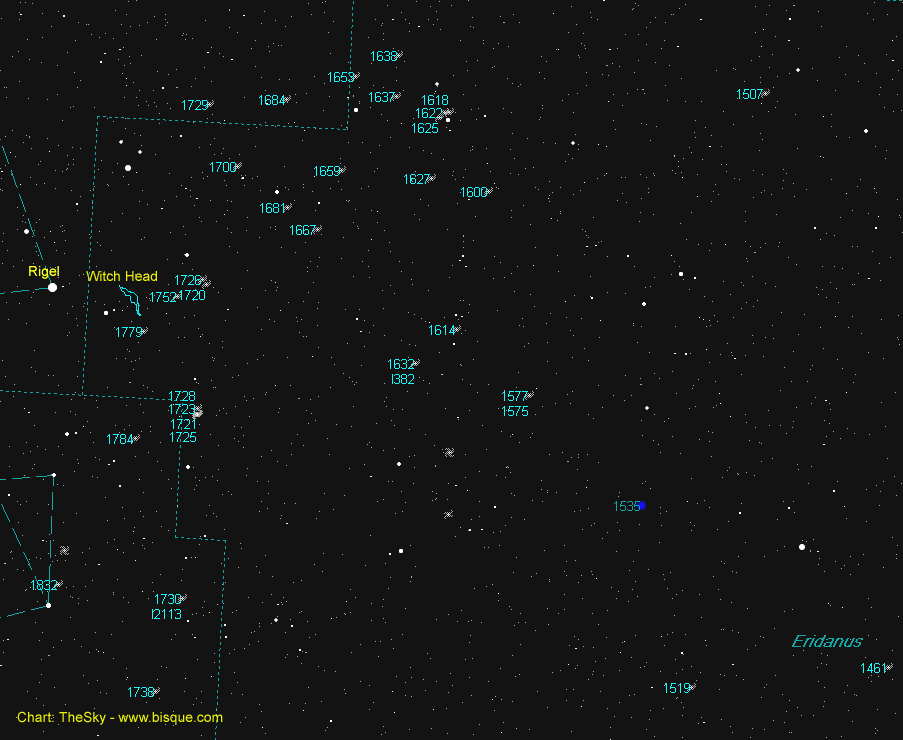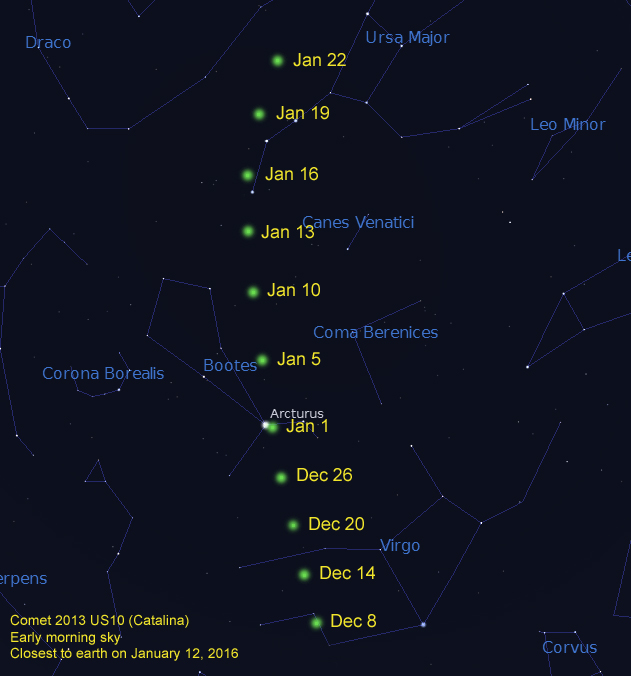The River Eridanus
The mighty river in the sky called Eridanus is a wide and lengthy constellation. Commencing near the magnitude 0.2 star named Rigel, Eridanus stretches more than two hours of right ascension to the west but continues far south beyond our field of view. From Canada, we only see half of the lengthy pattern. Eridanus ends the journey at the star Achernar, located at declination -57 degrees. Achernar (alpha Eridani) is a class B6 white star, 140 light-years from Earth. Its surface temperature is estimated between 14,500 and 19,300 Kelvin and is eight times more massive than our Sun. Achernar also spins rapidly on its axis with a complete rotation in less than 2.1 days compared to the Sun’s 25.4 days. Achernar is ranked amongst the ten hottest and bluest stars of the night sky. If you are vacationing south this winter below latitude 30 degrees north, try to spot the end of this celestial river.
At the opposite or northernmost part of the river is the star Cursa (Beta Eridani). At 89 light-years from us, this spectral class A3 white sun is listed at magnitude 2.78 and has a surface temperature of 8,400 Kelvin. Cursa belongs to a rare group of only a couple of dozen stars that produce huge flares as was the case in 1985. During this event, Cursa was observed to increase three magnitudes in brightness for more than two hours.

From our vantage point in the north, Eridanus offers a good selection of galaxies down to 13th magnitude. As well, there are a few galaxy groups such as the trio of NGC 1618, 1622 and 1625 located in the top left section of the constellation. All three are elongated galaxies located around the 109 million light-years distance and appear in a field of view, half the width of the full moon. Another impressive group of four galaxies consists of NGC 1728, NGC 1725, NGC 1721 and NGC 1723. First look for NGC 1723 at magnitude 12 as it appears to be the brightest of the group. You should then notice the remaining trio a bit to its south. These three are listed a bit fainter at magnitude 13.
The only planetary nebula within the boundaries of Eridanus is NGC 1535. Also known as Cleopatra’s Eye, this planetary has a high surface brightness that still looks great under high magnification. At 5,800 light-years away, NGC 1535 bears a resemblance to the Eskimo Nebula located in the constellation Gemini. A ghostly reflection nebula called the Witch Head nebula is located a bit south of Cursa. This interstellar gas cloud is being lit up by the star Rigel. This is an extremely hot star located 862 light-years from us. In this image south is up and Rigel is to the right and is about 1,000 light-years from Earth.
Comet Catalina is still putting on a great show as it treks northward. Catalina is showing its gas and dust tails and is a treat for astrophotographers. Any exposure on a DSLR camera will reveal its iconic green colour of the nucleus and the tails. On New Years' night, Catalina will be close to the star Arcturus. The comet will be about 9.5 light minutes (120 million km) away with the star being 37 light-years (370 trillion km) away. Its closest approach to Earth or perihelion will occur on January 12 at which point the comet will be 108 million kilometres away from us or 284 times the average Earth-Moon on distance. From January 15 to 17 watch the comet moves parallel to the Big Dipper’s handle. Over the next few months, Catalina will get fainter and leave our solar system forever.

A meteor shower is usually named for the constellation where the meteors seem to come from (radiant) such as the Lyrids, Leonids etc. However, this meteor shower is named from the constellation Quadrans Muralis which no longer exists. It was created in 1795 and was located at the intersection of constellations Bootes, Draco and the end of Ursa Major’s tail. But even though the constellation no longer exists, we still refer to it by name. The parent body that created the shower is thought to be from a recently discovered asteroid named 2003 EH1 which is likely an extinct comet. The asteroid might even be comet C/1490 Y1 that was observed and recorded by the Chinese more than five hundred years ago.
Four of the five naked-eye planets are now visible in the early morning hours. First, there is brilliant Jupiter rising due east at 11 p.m. local time on January 1. The “King” of the planets exhibits its four main Galilean moons that from time to time transit across the Jovian surface. You can follow their path along the planet’s backdrop along with its shadow seen on Jupiter’s cloud tops. Please refer to page 231 of the RASC Observer’s Handbook 2016 for the time table of disappearance and reappearance events. Keep in mind all times are posted in Universal Time (UT) and you must convert to your specific time zone.
Mars is next to rise a little more than three hours after Jupiter. From now till the end of May, the red planet will gain in brightness and overall size. With Mars being farther from the Sun than we are and taking longer to orbit the Sun, our two planets are closest every 26 months. The conjunction will occur on May 30. By 5 a.m. on January 1, Venus is seen climbing from the southeast with the ringed planet Saturn some 45 minutes later. As Venus is sinking farther east each day, it will be extremely close to Saturn on January 9.

New Moon (lunation 1151) will occur on January 9 at 8:31 p.m. EST. From time to time the moon moves in front of bright stars and planets, this is called an occultation. This month the 82% lit moon will hide the star Aldebaran located 66 light-years away on the night of the 19th starting after 9 p.m. EST and lasting about an hour and a half. The full Wolf Moon occurs at 8:46 p.m. EST.
Until next month, clear skies everyone.
Twitter: @astroeducator
